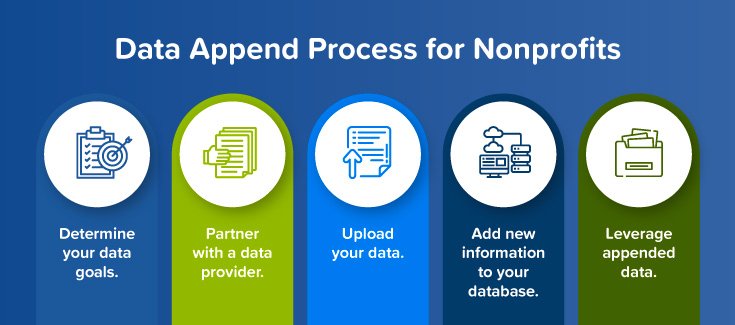
As data becomes an increasingly integral part of nonprofit fundraising and marketing, charitable organizations need to stay up-to-date with the latest data trends—one of which is appending data.
AccuData defines a data append as the act of “supplementing the information within a brand’s internal database with additional data from external sources.” In this guide, we’ll explore how a data append works and how your nonprofit can leverage this powerful process to enrich your donor database and unlock untapped fundraising and marketing potential.

Steps for the Data Append Process
- Determine your data goals.
- Partner with a data provider.
- Upload your data.
- Add new information to your database.
- Leverage appended data.
- Business affiliations
- Stock ownership
- Real estate value
- Past donation amounts
- Nonprofit engagement history
- Full names
- Contact information
- Employer information
- Preferred communication channels
- Create data entry rules. Make it clear how you’d like your staff to input new information into your database. For example, you may prefer that they add a set of parentheses around phone number area codes instead of dashes: (123) 456-7890. These types of rules create consistency within your database and make it easier to navigate.
- Remove any inaccuracies. After your data append, comb through your database to find any problem areas. You may notice duplicate records, data entry errors, or deceased supporter data. Develop a plan to resolve these issues with your team.
- Make it an ongoing process. Conducting a data append provides an important reminder that data cleanliness is dynamic. The more data you add to your database, the more you put it at risk of becoming disorganized or inaccurate. Create a reminder to regularly check your database and ensure it remains a source of truth about your supporters.
1. Determine your data goals.
Before you conduct your data append, provide focus to your efforts with clear goals. That way, you guarantee you’ll get the information you need and avoid cluttering your database with excess data points.
For example, if you’re running a capital campaign, you may want to focus on appending wealth and philanthropic indicators, such as:
This information will help you in the prospect research process so you can identify major donors and reach out to them accordingly. Alternatively, you may append more general pieces of information to round out your database. Double the Donation recommends storing the following data points:
For example, if you’re running an email marketing campaign, you could conduct a data append to add missing supporter email addresses to your database.
2. Partner with a data provider.
While you can look for additional data on your own, your best bet is to work with a data provider. Not only do they have the expertise to guide you through the process, but they also have access to unique data sets and can help you strategize about your data priorities.
Data providers typically offer a variety of data services, including data hygiene assistance, predictive analytics, and digital marketing campaign planning. When you discover the right provider, you can completely transform your data strategy and see better fundraising and marketing results.
Do your research to find a provider that works with nonprofits, as they’ll be more familiar with your specific data needs. Nonprofit data providers understand how nonprofit marketing differs from for-profit marketing and what data will enhance your fundraising efforts, allowing you to trust them to handle the data append process for your organization.
3. Upload your data.
Once you’ve found a data provider to work with, your existing data will be uploaded to their data append service. Then, the system will verify your records and match them with corresponding entries in external databases that the provider has access to.
The system will export the data you’ve chosen to append and add it to your records. Instead of scouring over hundreds of different data sources online to find the information you need, a batch append approach will save your team time and energy that you can devote to more mission-critical tasks.
4. Add new information to your database.
Wrap up your data append by downloading the newly sourced information and adding it to your database. To use this new influx of data to its full potential, ensure you have data hygiene protocols that keep your database organized and accurate:
A good rule of thumb is to review your database whenever you alter your fundraising or marketing strategy. For example, if your nonprofit sets quarterly goals, audit your database at the beginning of each quarter. That way, you can more easily identify which areas of your database to focus on cleaning and which types of data you’d like to append to fulfill your objectives.
5. Leverage appended data.
Finally, it’s time to put your new data to use. If you’ve added new contact information to your database, try reaching donors using multiple channels. For example, you may send the same group of donors an email and direct mail informing them about your upcoming event to see which method has a better response rate.
You can also use your new data to increase fundraising conversion rates with more personalized outreach. With a better understanding of your supporters, you can segment them into different groups based on shared characteristics.
For instance, you may separate donors by age and reach out with fundraising appeals that take each age group’s unique interests into consideration. You may use social media to market to 18-24-year-olds whereas your outreach strategy for senior citizens may focus on direct mail.
Whether you’re trying to retain donors, host an event, or kick off a fundraising campaign, a data append can ensure you have the information you need to make your goals a reality. Just make sure to supplement this data with insights from your supporters sourced from surveys and open conversations. That way, you can have a well-rounded view of who your supporters are and how they’d like to engage with your organization.
